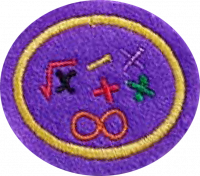Difference between revisions of "AY Honors/Math Skills I/Requirements"
(Marked this version for translation) |
Jomegat bot (talk | contribs) (Bot: Automated import of articles *** existing text overwritten ***) |
||
| Line 1: | Line 1: | ||
| − | + | {{HonorSubpage}} | |
| + | |||
| − | |||
<section begin=Body /> | <section begin=Body /> | ||
| Line 51: | Line 51: | ||
[[Category:Honor Requirements|{{#titleparts:{{PAGENAME}}|1|2}}]] | [[Category:Honor Requirements|{{#titleparts:{{PAGENAME}}|1|2}}]] | ||
[[Category:Honor Requirements Revision 3|{{#titleparts:{{PAGENAME}}|1|2}}]] | [[Category:Honor Requirements Revision 3|{{#titleparts:{{PAGENAME}}|1|2}}]] | ||
| − | </translate></noinclude> | + | <noinclude></translate></noinclude> |
| + | {{CloseHonorPage}} | ||
Revision as of 04:06, 19 March 2021
1. Know the decimal system.
2. Know how to identify and classify the algorithms of the decimal system and represent the position of each.
3. Classify and identify the four basic operations, representing each algorithm by using four examples.
4. Show four practical examples in which the four basic operations are used and solve.
5. Investigate and present with a design or in writing the possible origin of the signs of square root, division, addition and subtraction.
6. Demonstrate in practice the solution of at least three examples of exponentiation and three examples of numerical expression, using the signs of parentheses, brackets and braces.
7. Present and solve three practical examples of situations involving fractions in addition, subtraction, multiplication and division operations. Remember that LCM is used for addition and subtraction operations.
8. Present and demonstrate the solution of three problems that involve percentage calculations for purchase and sale of products, obtaining discounts.
9. Present and demonstrate the solution of four operation examples with decimal numbers in addition, subtraction, multiplication and division, using the practical method to solve.
10. Present with a poster or multimedia five examples of flat figures and five examples of solid figures showing their characteristics, and next to it what type of day-to-day object uses that shape.



